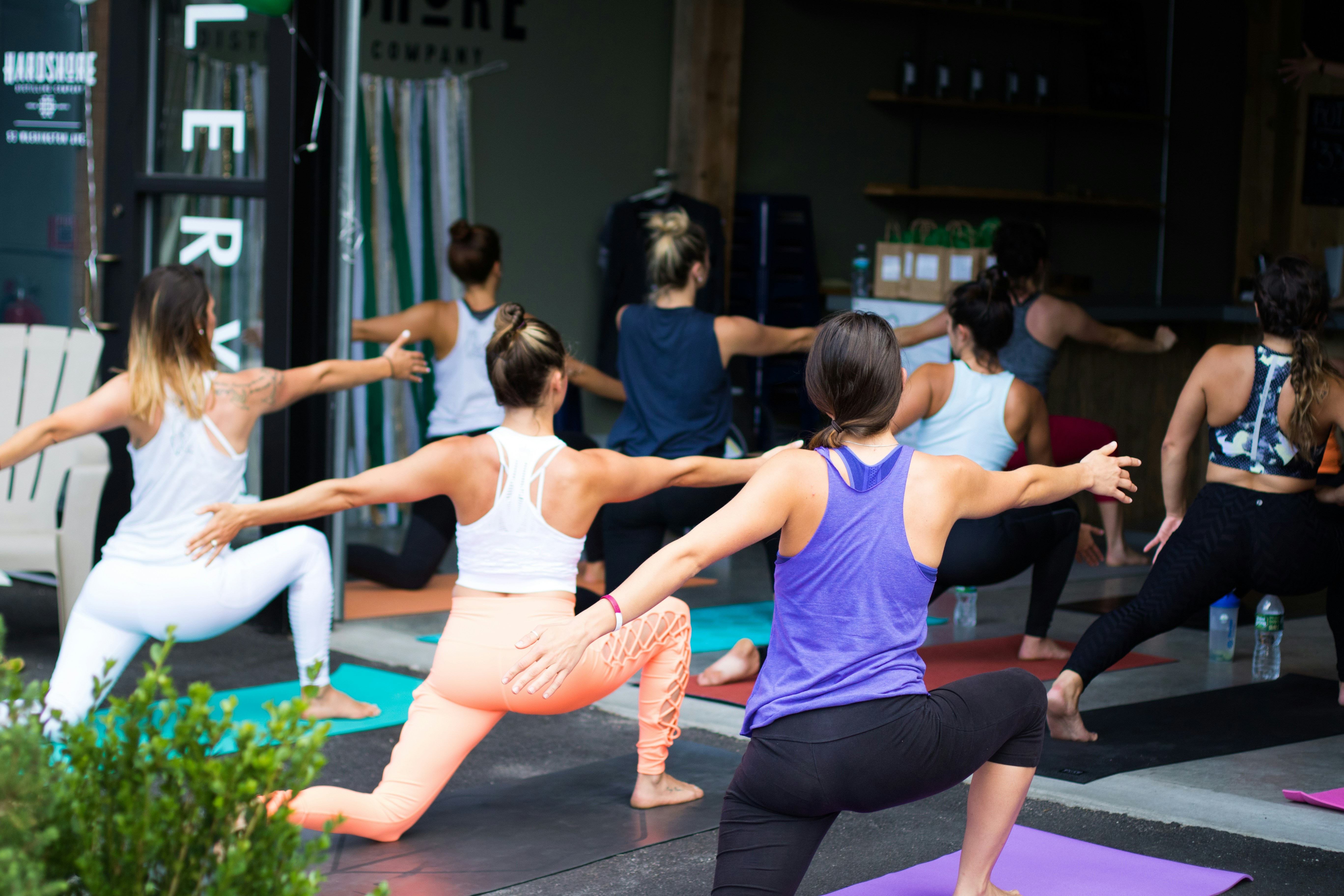It’s time to elevate your cycling game! Discover the best cross-training exercises guaranteed to boost your power, endurance, and prevent injuries.

Photo from Brian Erickson (via Unsplash)
Cyclists love to ride their bikes. It’s true of both amateurs and pros alike — after all, that’s why they call themselves “cyclists,” sometimes even for their full-time job. And cycling feels amazing when it’s just you and the open road. But relying solely on your weekly (or daily!) rides can lead to plateaus or injuries. It’s time to introduce the magic of cross-training: diversifying your everyday workouts with activities like swimming or yoga. Why? Think about the powerhouse legs you can get from squats, the core stability from Pilates, and the lung-busting endurance you build through hiking. These aspects of fitness are all important for cycling just as they are for other sports and activities! Not only will you experience performance gains from cross-training, but also reduced risk of overuse injuries and a mental break from being in the saddle that prevents burnout. Keep reading to learn how to ditch the cycling tunnel vision and reach your full potential with simple cross-training.
Read more: Ride Smarter, Not Harder With “Zone 2” Cycling
Why cross-train?
While cycling offers incredible fitness benefits, it’s not without its downsides. One key weakness is its unilateral nature, stressing mainly the legs and neglecting upper body development. This can lead to muscle imbalances and potential injuries. Additionally, cycling strengthens quads and hamstrings, which can leave core stability underdeveloped. The strength of your core is crucial for efficient power transfer and back health. Flexibility can also suffer on the bike, especially in tight hip flexors and hamstrings, limiting range of motion and comfort on the bike. Finally, while cycling builds endurance, it does so in a specific way, lacking the explosive power developed through activities like plyometrics or HIIT training. While there’s no doubt cycling is fantastic exercise, incorporating cross-training to address these weaknesses is essential for a well-rounded and injury-free experience.
Read more: 5 Ways Cycling Transforms Your Body (CyclingScoop)
Choosing the best cross-training isn’t one-size-fits-all.
You have to do some soul-searching to determine the right cross-training for you. Consider your lifestyle and preferences: outside of cycling, are you kind of a gym rat or an outdoors lover? Do you crave high-intensity workouts or something more low-impact? Think about your fitness goals first and foremost: do you want to build strength, improve flexibility, or boost endurance? Finally, listen to your body: do you have any pre-existing injuries or limitations to consider?
Once you understand your unique needs, explore the options below to find the best fit for you. Remember, the best cross-training is the one you’ll stick with, so choose something you genuinely enjoy!
Ready to figure out which cross-training works for you? Read on!
1. Yoga
For cyclists, hitting the road is what it’s all about, but can’t it leave your body tight and imbalanced? Especially the next day, where you might feel really stiff and achy. Enter yoga, your perfect antidote. Yoga poses stretch and strengthen key muscles often neglected by cycling, like your hamstrings, hips, and shoulders, improving your flexibility significantly. It also works wonders on your core, boosting stability and power transfer in the saddle.
Looking for some specific poses to try? Flow through Downward-Facing Dog to lengthen your hamstrings and spine, Pigeon Pose to open your hips, and Warrior II to strengthen your legs and core. Don’t forget to try Plank and Cobbler’s Pose for core stability and hip flexibility.
For yoga, cross-training can be mental, too. A focus on breathwork and mindful movements calms the mind, reducing your stress and enhancing your focus. Next time you’re looking for a perfect low-impact follow-up to your long ride, consider rolling out your yoga mat. You might just be surprised how yoga takes the edge off!
Read more: 7 Amazing Yoga Positions for Cyclists (CyclingScoop)
2. Running
It’s nobody’s favorite, but incorporating a little running as cross-training unlocks some surprising, unique benefits for your body and mind. Running targets the opposite muscle groups compared to cycling, strengthening your upper body, core, and glutes. It also improves your body’s energy economy, making you a more efficient cyclist by teaching your body to utilize oxygen better. You might feel slow and exhausted after running at first, especially if you are more used to the slow endurance nature of most cycling. However, the running adjustment process will give you better “burst” potential on the bike as well.
Don’t be discouraged by the impact; choose softer surfaces and start slow to minimize stress on your joints. If you want to get away from the pavement, consider trail running as an equally beneficial form of cross training. Bonus points: running will enhance your mental toughness, translating into pushing harder on challenging climbs and battling fatigue on long rides.
When you lace up your shoes and hit the trails, you will feel the positive impact of running flow into your cycling performance.
3. Swimming
Many people hate running. I don’t blame them because I hate it too. Luckily, the solution may be as simple as diving into your local pool for a few laps instead.
Swimming isn’t just a refreshing escape from the heat of the summer for cyclists; it’s a powerhouse of cross-training benefits. Imagine this: a low-impact swimming workout will sculpt your arms and shoulders, counteracting the legs-first nature of cycling. Swimming engages your entire core and back, boosting stability and power transfer when you get back on the bike.
The chill rhythm of swimming also calms the mind, just like you feel on a long Sunday afternoon bike ride. And who doesn’t want that? Trade your bike for a swimsuit sometimes and see if swimming as cross-training might work for you.
Read more: Is Swimming Good Cross-Training for Cycling? (Adventure Cycling)
4. Rowing
This one is a secret favorite of many accomplished cyclists. For those seeking the ultimate full-body cross-training option, look no further than rowing! When your legs push off the footplate, you engage your core for stability and pull with your arms – that’s the magic of rowing. It will strengthen your legs further while also engaging neglected upper body muscles, creating a more balanced physique.
Like with swimming, rowing is a low-impact yet high-intensity workout, which is ideal for building cardiovascular endurance without stressing your joints. Plus, it improves flexibility in your back and shoulders, enhancing your comfort and handling on the bike. You can try rowing on the rowing machine at the gym, or by joining a local rowing team in your area. Committing to a rowing program is a great way to stay focused on cross-training for the long haul.
5. Cross-country skiing
Have the winter blues got you down? Many cyclists just switch to riding on the smart trainer during the colder months, but you can incorporate some cross-training in your routine as well. Swap our your bike for skis to see how cross-country skiing is a great off-season training ground for cyclists.
Skiing through a serene winter wonderland and gliding over snow-covered trails is the perfect winter adventure for a cyclist. But beyond the scenic landscape, cross-country skiing unlocks a treasure trove of benefits for your body as well. Firstly, it reinforces the leg movements developed through cycling, strengthening your quads, hamstrings, and glutes. This keeps building your power and endurance through the off-season, translating to stronger climbs and sprints alike on your summertime rides. Secondly, just like with rowing, the double-pole technique works wonders for your upper body and core. And it’s low-impact, helping your improve your cardiovascular health without stressing your joints. This is perfect for injury prevention and rehabilitation.
Next winter, think about bundling up and embracing the snow for awhile! You might just find cross-country skiing is a perfect cross-training fit for you and paves the way for stronger, healthier bike rides come spring!
Read more: Why Cyclists Should Add Cross-Country Skiing to Their Winter Training Routine (Bicycling Magazine)

Photo from Dylan Gillis (via Unsplash)
How much cross-training is enough?
Unfortunately, there’s no one-size-fits-all answer. It depends on several factors, including your current fitness level and cycling goals. Beginner cyclists might build fundamental fitness through cross-training, while experienced cyclists aiming for peak performance need more targeted efforts. If you spend most of your week cycling, you might need to adjust the amount of cross-training you do compared to someone who cycles on the weekends only. High-intensity workouts also might require more recovery time than low-impact activities like swimming.
As a general guideline, beginners should aim for 1-2 cross-training sessions per week, focusing on building basic strength, balance, and flexibility. Intermediate cyclists can aim for sessions of the same duration and frequency, with more focus on incorporating activities that address specific weaknesses. The most advanced cyclists should aim for 3-4 sessions per week, including a mix of high-intensity and low-impact workouts to target various fitness areas.
Read more: 5 Gym Workouts That Actually Work for Cyclists
No matter what, remember that consistency is key! Even a few regular cross-training sessions can significantly improve your cycling performance and prevent injuries. Listen to your body, adjust your training based on your needs, and most importantly, have fun exploring different fitness activities!
Are you ready to improve your cycling fitness with cross-training?
There you go! Now you’re ready to enrich your cycling life with a little cross-training. Cross-training is a well-rounded way to boost your cycling performance and keep things interesting in your fitness life. With it, you’ll climb stronger, pedal further, and avoid any injuries that might happen along the way. Remember, stay consistent! Find activities you enjoy and incorporate them into a routine. Soon you’ll be conquering those cycling goals in no time!
Read more: Want more cycling guides for beginners to advanced riders? Read our latest here!
What’s your favorite form of cross-training? Let us know in the comments below! We’d love to hear what you do to stay fit, especially in the winter months. ★










Leave a Reply